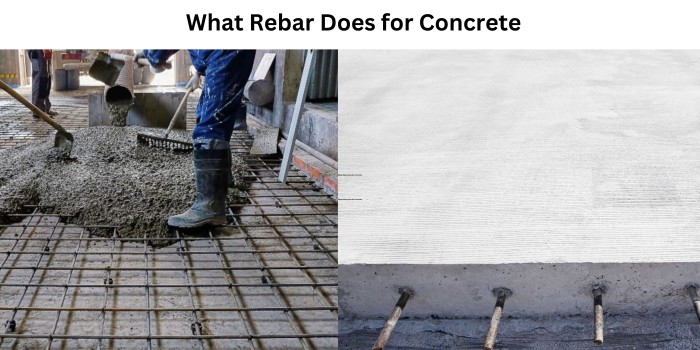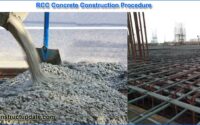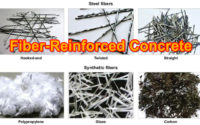What Rebar Does for Concrete | How Rebar Strengthens Concrete | Types of Rebar
For ages, people have been using concrete, a magnificent building material, to build large-scale industrial and commercial projects like bridges, buildings, and dams, as well as foundations, slabs, sidewalks, and patios. Concrete is often used for small decorative projects like planters, countertops, and cast fireplace surrounds. Its primary characteristics are compressive strength, weather resistance, and durability. i.e., it is capable of bearing a substantial weight without breaking.
However, its tensile strength is where it falters. Nevertheless, a reinforcing bar, or rebar, can be added to solve this. Why is rebar used in concrete? It fortifies itself with a metal skeleton, which considerably boosts its strength.

The main function of rebar is to make concrete more strong. This extra strength helps it withstand cracks and makes up for the inherent weaknesses of concrete, such as its propensity to crack in cold weather due to temperature swings and freezing water. For concrete driveways, patios, sidewalks, and foundations, this is a big benefit.
Concrete can safely cover greater distances because of its higher tensile strength, which allows it to withstand breaking under tension. Many of the bridges, dams, and structures you see today are made possible by the use of rebar in concrete. Most contemporary residential and commercial structures could not be built without rebar.
Following are some tips and detailed information on how and why rebar makes concrete stronger.
What is Concrete? Let’s Understand Concrete First.
Cement, sand, and aggregate stone are combined with water to make concrete. Cement and water undergo a chemical reaction to create a paste that needs time to dry and solidify—a process known as curing. This usually takes 28 days to finish. Concrete dries, warms up, solidifies, and becomes extremely strong with a high compressive strength throughout this period. nonetheless, very little tensile strength.
Sand and aggregate stone give concrete strength, even if cement and water are its active constituents. Without these two ingredients, cement is far weaker and more prone to cracking.
Concrete is a porous substance that takes in moisture. Internal water evaporation during the curing process of the concrete results in numerous tiny tubes extending throughout the building. These tubes take in water like a sponge with ease.
Because of its structure, concrete has a high compressive strength but a very low tensile strength. These internal tubes and holes are brittle.
For instance, the middle of a thick concrete beam that is supported at both ends has very little strength and will eventually shatter even when the beam is supported solely by its own weight.
Psi, or pounds per square inch, is the unit of measurement for concrete strength. This represents its compression strength of it. Three thousand pounds per square inch can be applied to a concrete bag at 3500 psi without it breaking. But its tensile strength is unrelated to this 3500 psi.
Concrete aggregate can have its type, size, and quantity changed to change the material’s compressive strength. However, none of these will materially alter the compressive strength of the material.
The only way to considerably raise the tensile strength of concrete is to add reinforcement such as wire mesh, chemicals, fiber, and rebar.
What is Rebar? Let’s Understand Rebar.
Rebar gives a concrete structure more tensile strength. In order to stop cracks and structural damage, it helps distribute weight and bind the structure together.
By itself, concrete is an incredibly robust and long-lasting building material. For centuries, people have used it to construct buildings all over the world. But before rebar was developed, those structures had significant limitations. Thanks to the addition of rebar to the concrete, we can now construct almost anything out of it.
Although concrete is particularly effective when subjected to compression forces, it requires assistance when bearing tension. For instance, weight is supported at both ends but not in the center of a beam. Since the center of concrete experiences the highest tensile stress, it has historically been unable to span large distances. However, it can with rebar. Big concrete structures are constructed in this manner.
Concrete that has 4,000 pounds per square inch (psi) of compression strength may only have 400 psi of tensile strength. By comparison, that is incredibly low. Rebar, however, can actually raise the tensile strength above the compression strength of the concrete.
Rebar also helps with the expansion and contraction forces caused by changes in temperature.
When a concrete structure tries to expand and contract, rebar keeps it together.
A concrete structure’s internal reinforcing bar may be just as significant as its external reinforcement. Be advised that the strength of a well-engineered rebar structure within a concrete building, wall, bridge, or foundation usually comes from this source.
Rebar is what allows for the majority of contemporary constructions.
Why Rebar Makes Concrete Stronger
You need the concrete to withstand both tensile and compression loads because these loads are almost universally experienced by concrete structures. But concrete by itself struggles to manage tensile strength.
Anywhere there are load points, a concrete beam will withstand compression when weight is applied from above. Providing it has the necessary pressure. If there is no support, it will also suffer from extreme tensile stress. For example, in the center of the beam. This sets up an environment where fractures and structural failures are likely to occur.
This is on top of the earth and concrete’s movement, vibration, and expansion and contraction. Tensile forces characterize all of these forces, which is a major weakness of concrete.
Because rebar has a higher tensile strength than concrete, it helps to relieve these stresses. Rebar inside concrete therefore helps to strengthen it in all the areas that it most needs to be strengthened.
Types Of Rebar
Rebar appears “plain” or “deformed.” Deformed rebar has ridges that aid in bonding it to the concrete. In situations where the steel needs to “slide” into the concrete, plain rebar—which lacks ridges—is utilized.
Here are the most common types of rebar.
Carbon Steel:
The most widely utilized kind of rebar. Despite corroding readily when exposed to the elements, it is reasonably inexpensive and strong.
Reinforced polymer with glass fiber (GFRP):
Also known as “fiberglass rebar.” Because it has even greater tensile strength than conventional steel rebar, it’s a good substitute. Because it is composed of fiberglass wrapped in resin, it will never corrode. It is very costly in addition to being very strong.
European:
A less expensive variety of manganese rebar. The formats used for measurement differ from those in the United States. It gives structural concrete strong reinforcement.
Epoxy Coated:
Also referred to as “green bar.” Because it resists corrosion so well, it is primarily used in wet environments, such as bridge construction. This low-cost rebar is made to withstand corrosive conditions. The epoxy coating on the rebar prevents corrosion. It’s not a wise decision, though, in areas where shifting soil, fissures, or vibrations could harm the protective layer. The effect of the coating is negated when cracks reveal the steel.
Galvanized:
Very resistant to corrosion; it costs more than epoxy-coated rebar. Zinc is applied to galvanized rebar through a variety of techniques, such as electroplating, hot plating, and cold plating. Over the steel, the zinc acts as a barrier of defense.
Stainless Steel Rebar:
Although it is the priciest rebar, it is also the strongest and most corrosion-resistant. mostly utilized when zinc and epoxy are not suitable. It’s used only in dire circumstances due to its exorbitant cost.
Related Posts

RCC Concrete Construction Procedure – Procedure for Reinforced Concrete Construction (RCC)

Fibre Reinforced Concrete (FRC) Advantage, Uses, and Types

Tunnel Construction Methods and Safety Tips
About The Author
John Steffen
I love to share my experience on civil engineering and construction estimates. As a highly capable individual with a strong academic background, I am proud to say that I already possess a comprehensive understanding of the technical elements of civil engineering.


